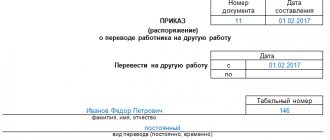Change of position
A change in position can be either a regular change in the name of an employee’s official position or a transfer.
In both the first and second cases, the procedure will affect the employment contract drawn up between the employee and the employer.
Changes that occur through transfer are formalized if a person’s job functions in the company where he works have been adjusted, or the structural unit itself has been changed.
The labor function includes the official position specified in the staffing table, profession, specialty, qualification, and type of work entrusted to the employee.
Translation is possible:
- temporary;
- constant.
Constantly, in turn, they translate:
- for a new job or position with the same employer;
- for work in another area together with the employer company;
- to another employer.
All actions of a permanent nature must be accompanied by the written consent of the employee.
Important! Changing the name of an official post without changing labor functions is not a transfer.
Getting another position
If an employee moves to a new position, this is a process of changes, established by the parties, to the terms of the employment agreement. Such changes require only mutual consent of management and employee.
The law allows exceptions in the form of a transition for some time. The transition to another position by agreement of the parties must be documented.
Transfer to another position
Transferring an employee to another position is a significant change in the conditions of his work activity, which must be accompanied by appropriate entries in the employee’s labor documentation.
As stated above, an employee can be transferred either temporarily or permanently.
A temporary appointment is if:
- the period does not exceed a period of time of 1 year;
- an employee was transferred during the absence of a certain employee, whose job is retained, for example, while a woman is on sick leave for pregnancy and childbirth. The appointment period will last until the absent employee returns to his workplace.
In such situations, everything is formalized by written agreement between the employee and the employer. Accordingly, additional provisions must be made to the employee’s employment contract. agreement.
A temporary transfer for a period of up to one month from the same employer, taking into account legislative acts, does not require the written consent of the transferred person if:
- there are unforeseen circumstances, for example, fire, accident, natural disasters, and so on;
- for a number of reasons there was downtime at the enterprise;
- for a period of temporary absence of an employee caused by emergency circumstances.
Important! A person can be transferred to another, less qualified position only if he has no written objections.
When, guided by the Labor Code of the Russian Federation, a person is transferred without obtaining his consent, then his earnings from his main place of work must be retained, and not lower than average.
Translations are:
- Initiative. Occur directly at the request of an employee or his employer; there may be a petition from a trade union organization. The basis for this type of transfer will be the arisen production need and the person’s consent to perform new duties.
- Uninitiative. Often these actions are forced on both sides and arise due to the deterioration of the employee’s health or other circumstances that cannot be foreseen in advance. In this case, the employee's consent is required.
- A pregnant woman for light work or a reduction in her production standards. In this case, the basis will be a medical report and the woman’s statement. If the employer cannot offer her a suitable place, then the pregnant woman is temporarily suspended from work while maintaining her earnings and her official position.
- Simultaneously with the employer to another area. This fact can happen if, for example, a company begins to rent premises outside the city, since it is cheaper. In this case, staff should be notified and written consent should be obtained from each employee. If a person does not agree with this transfer, he will be dismissed with severance pay.
Changes in work books
These documents are drawn up by responsible persons. This work can be performed:
- Specialist in personnel finishing.
- The leader.
- Chief accountant.
All entries are confirmed by the HR employee. After changing a position, the following actions are performed:
- An agreement is signed to transfer the employee to another position.
- A corresponding note is placed in the work book.
- An order is issued stating that the employee has received a new position.
Before data is entered into the work book, the owner of the document is introduced to the information, who must confirm everything. It states:
- Record number.
- Date of changes.
- Information about the translation.
- Order details.
Creating an agreement to transfer an employee to another position and filling out a work book is considered mandatory. If the manager follows all the specified rules, then all documentation will be in order. And then no questions will arise during inspections by regulatory authorities.
Additional agreement on transfer to another position
An additional agreement to the employment contract on the transfer of an employee to another position is prepared when it is necessary to adjust (supplement) the contract or agreement. This document will actually be a continuation of the contact. Consequently, the preparation of additional Agreements to an employment contract or contract on transfer to another position require 2 copies: for the employee and for the manager.
For example, sample additional agreements to an employment contract on a change of position can be presented consisting of the following points:
- Name and number.
- Indication of the parties.
- Main part.
- Number.
- Details (if necessary) and signatures.
Additional sample transfer agreements are generally accepted and are used in all organizations.
The procedure for drawing up an additional agreement to the agreement on changing positions is also defined.
There is no standard document form; the employer has the right to draw it up at his own discretion. However, a number of necessary requirements will need to be met.
- Due to the fact that additional The agreement is part of the contract; it should be drawn up in the same form as the employment contract itself with the employee.
- Additional is being prepared. agreement in writing, in 2 copies - one each for the employee and the employer.
- The title should look like this: “additional agreement to the employment contract dated ... No. …”.
Attention! A document called an “agreement” is not an additional document. agreement to the employment contract and is not given the opportunity to adjust its terms. It may indicate some lack of objection by the employee that is not related to changes in the contract.
Let’s say that an engineer performs additional work that is not included in the list of his duties prescribed in the employment contract and is not related to the work performed under it.
- In the “header” additional. the agreement indicates the date and place of its conclusion. Here you should indicate the parties and indicate the document giving the right to act to the official - the representative of the employer.
- Further in the text add. the agreement must reflect the amended version of the clauses of the employment contract and supplement it as necessary. Indicate the date from which the new obligations come into force.
- The extra is running out. agreement signed by the parties. It is important that it must be endorsed by the employer or an authorized official who has the right not only to sign contracts and agreements, but also to take appropriate actions. In this case, change job responsibilities.
- If the details of the parties remain unchanged, then they can not be entered, as they were previously recorded in the employment contract.
- In addition The agreement must include a line for the visa of the relocated worker, with which he will confirm receipt of his copy.
Conclude additional an agreement should always be made when adjustments need to be made to the contract as provided for in Article 57 of the Labor Code of Russia.
Translation with consent
This procedure is carried out as follows:
- The boss prepares a report indicating the reason for the transfer and information about the employee.
- The head of the department gives permission.
- The employee is notified in writing of the offer of another position.
- The employee provides written confirmation and submits a statement to the manager requesting a transfer. The application must be completed.
If registration is carried out only for some time, then this fact is not reflected in the work book. An additional agreement is created on an ongoing basis to transfer the employee to another position.
Sample additional agreement
You can below:
Sample additional agreement to an employment contract
Permanent and temporary transfers differ in that with permanent transfers, the employee not only receives new job functions on a permanent basis, but also appropriate changes are made to his personal documents at the enterprise. As for the temporary change in duties, this will be recorded by means of an order.
Important! The transfer of an employee to another official position must occur if he has no objections and in accordance with the legislative acts of Russia.
Is written permission required?
An employed person receives a new position based on the following conditions:
- For a while or for a permanent position with one boss.
- Together with the boss to another place.
- Transfer to another boss.
A transfer involves a change in the employee’s employment or a move to another location where the same management will work. If a person is transferred on the basis of the employer’s initiative, the employee must give written consent. If the translation does not require additional movements, then permission is not required (Article 72.1 of the Russian Federation).
A worker can transfer at his own request; to do this, he must submit an application to the manager. The transfer is carried out both on the basis of his request and on medical recommendations. If there is a transition to a permanent job, but to a different boss, the document will not be valid in the previous place. An additional agreement for transfer to another position is drawn up only if the employee gives consent to this.
Difference between job change and transfer
Do not confuse the transfer and renaming of a position or department as a whole.
The legislation clearly distinguishes between these 2 concepts.
Thus, a transfer is a temporary or permanent change in the functions of an employee or a structural unit, as well as the movement of an employee to work in another area together with the employer. Here, in fact, people's working conditions will change significantly.
As for renaming, only the name of the employee’s official post or the name of the structural unit changes. In this case, all labor functions remain unchanged.
As an example, consider the position of a sales engineer in the wholesale department.
- If he is offered a job as a freight forwarder in the same department, this fact will be considered a transfer, since, along with the title of the position, the employee’s responsibilities stipulated by the employment contract concluded with him will also change.
- If he is transferred without changing his position to a department, say, retail sales, this will also be a transfer, since the structural unit specified in the contract, that is, the department, will change.
- If both of the above facts happened at the same time, this is a translation.
- If they decided to rename a sales engineer as a sales manager, but his type of activity and structural unit remained the same, therefore, the position was solely renamed, without adjusting the functions of the employee and his structural unit.
There is also a difference in the design of translation and renaming.
By changing essential working conditions:
- A corresponding adjustment is made to the staffing table, a corresponding unit is introduced or added to which the employee is transferred.
- An additional agreement on the transfer is being prepared.
- An order is issued.
- Relevant entries are made in the employee’s personal documents on an ongoing basis.
When renaming:
- An order is issued that the staff list is changing.
- Adjustments are being made to the staffing table.
- The employee is given a notice that the name of his official position has changed, indicating the reason.
- If the title of the official position of the head of the organization has changed, then the Charter of the enterprise will also need to be adjusted.
- Information about the renaming is reflected in the personal personnel documents of employees.
Transfer of an employee
The transfer of an employee within the same enterprise is a regular practice . An employee is allowed to be transferred to another department, to a new position, and also to change working conditions.
The Labor Code contains concepts that are similar in meaning - movement and transfer . They differ in the design mechanism and the necessary grounds. Translation is a softer form of translation. In addition, there are permanent and temporary transfers. This issue is regulated by Article 72 of the Labor Code.
As an example, let's focus on one of the most common cases - permanent transfer of an employee. The basis for this kind of change can be many reasons: promotion/demotion (of an employee in position), according to medical. reasons due to the relocation of the enterprise to a new location .
At the same time, hundreds and even thousands of employees can be transferred during the reorganization or optimization of the enterprise.
In labor legislation, types of changes are divided into three groups :
- Transfer due to a change in the employee’s job function (while continuing to work at the enterprise). If the function remains unchanged, and only the name of the position changes, then it will be unnecessary to formalize the transfer separately - it is enough to conclude an additional transfer. agreement.
- Changing the department in which the employee carries out his work activity (while continuing to work at the enterprise). A department is understood as a workshop, area, or structural unit of an organization.
- Moving to a new place of work, in another territory - for example, moving to a new office (in another city) will formally be considered a transfer. Moving within the boundaries of one locality should not be processed as a transfer.
A transfer can simultaneously combine elements of all three types —change of job function, change of department, and relocation. An example would be a large-scale reorganization of a company with a complete move to another city. In this case, the employee may be involved in performing a new job function in another department of the enterprise, as well as at a new place of work.
This is one of the main differences between translation and a similar procedure - “movement”. The movement of employees between departments of the enterprise is possible if the job function remains unchanged. Otherwise, such an operation will already be a transfer.
The relocation is easier to implement - it does not require the consent of the staff, the employer himself decides in which department there is a shortage of labor. However, medical indicators should be taken into account. Relocation, as well as transfer, is prohibited if it is contraindicated for medical reasons.
Attention! It is not allowed to assign another probationary period during transfer , since a new contract is not concluded.
Changes in working conditions
Working conditions must be specified in the employment contract. The employer cannot indicate the true assessment of jobs if he has not carried out such measurements.
Based on Article 57 of the Labor Code of the Russian Federation, it is impossible to write that working conditions are “good”. It is necessary to indicate each factor separately on a special scale. For example, the air temperature is 3.1, the intensity of the labor process is 3.3. The job evaluation application is presented below.
If it is determined that the working conditions belong to the “harmful” class, then the employer is fined, and the employee receives some privileges. For example, paid weekly leave, increased wages, etc.
A change in job evaluation can also be carried out due to the fact that the organization opens a new line of activity and the employee moves to a new position. The document must also be in 2 copies.
Notice form.
Temporary transfer
Temporary displacement of an employee to another service is possible only within one company. In some cases, such a transfer for a certain period of time may be carried out without the consent of the employee.
This is done due to emergency situations such as:
- industrial disaster, accident;
- accident (employee died);
- fire;
- earthquake;
- flood, etc.
In addition, appointment to another position can take place without the employee’s consent even if production is idle and if it is necessary to replace an absent employee.
Often, a transfer to another service is issued in the form of an order, i.e. without taking into account the wishes of the employee himself. But this should not be done, because even a short temporary transfer does not take place without changing the working conditions, work schedule and wages.
From the point of view of legislative rules, it is better to conclude an additional agreement to the employment contract.
Temporary transfer is possible for a maximum of 1 year. This shift is under no circumstances recorded in the work book, since only information about permanent work activity needs to be entered into it. Career growth in non-permanent work is no exception to this rule.
After the expiration of the temporary work period, the employee takes up his previous position.
Temporary position
There are often times when it is necessary to replace an employee who is temporarily absent. This usually happens during vacations, during temporary disability, or during maternity leave. Types of substitution are specified in the Labor Code of the Russian Federation:
- Transfer to another position
- Combination.
- Drawing up a fixed-term employment contract.
Transfer to temporary work is carried out due to necessity and due to situations not related to it. This procedure is carried out:
- Based on agreement of the parties.
- Execution by the employer unilaterally.
Employees are temporarily transferred for 1 year and for the period of absence of the main employee. Over time, the job may become permanent. At the end of the temporary transfer, the manager is obliged to notify the end of activities due to the return of the main employee. The notification must be in writing in 2 copies.
How to apply and its sample
Registration of additional The agreement does not establish any criteria. It can be written on any sheet of paper, with a pen or on a printer. The only thing that remains unchanged is that the signatures of the two collaborating parties must be real.
If a company uses its own stamps for all documents, then the additional agreement cannot be without a stamp.
The document must be in two identical copies, one of which is kept by the director of the organization, the other by the employee.
you can follow this link.
Sample additional agreement on transfer to another position:








